Tehran is a hot and sprawling metropolis. In some ways it’s bustling and chaotic—with the air pollution to match—but on the other hand the city’s meticulously-groomed parks provide ample space for the city’s 9 million residents to escape. There are some sites to be seen, but much of the city’s appeal stems from its unique brand of gritty cosmopolitanism—a stark contrast to many foreigners’ perceptions of the country.
In the shadows of countless palaces and mosques are cafes, museums, galleries and more. Around every corner there is something new to experience. But perhaps the most lasting impression is that of the people. Tehran will be most tourists’ first impression of Iranian hospitality. You may have heard much about it already, but as I and every other visitor can attest, any possible descriptions will do it a disservice. The only way to truly understand is to experience it yourself. And perhaps that same attitude applies to the city too; it can be yet charming, chaotic yet tranquil, tiring yet fun, repetitive yet exciting.
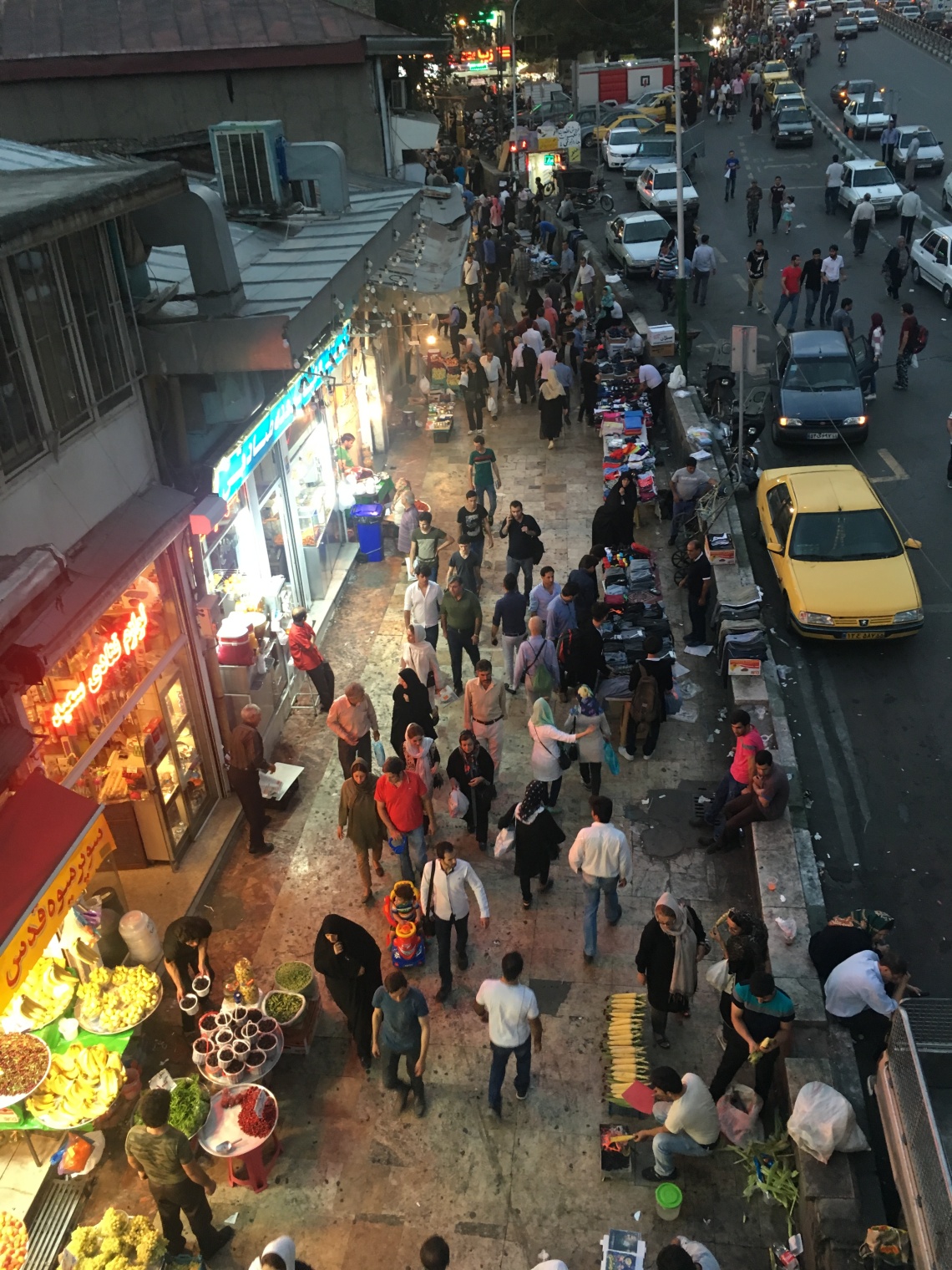
A focal point of the city is the Grand Bazaar, which is more towards the poorer southern suburbs. This expansive labyrinth offers everything from food, to apparel to homewares. It’s pretty huge, with thoroughfares totalling 10 km. Each stall looks as if it were in some cliched Middle Eastern bazaar from decades ago, but the things they actually sell are normal, modern products for regular people. While even the more mundane stalls might provoke some kind of weird Orientalist fetishisation from foreigners, this place is legit: it’s a normal shopping district for normal people. It’s not touristy at all, and that’s what makes it so great. Remember this when you arrive in Isfahan…
The bazaar also offers respite from the intense sun, the heat of which was compounded by me visiting during Ramadan (locally known as Ramazan). This kind of architecture which prioritises airflow, aims to create shadows and facilitates the removal of hot air is a logical tenant of the local vernacular. That’s where the consistency ends, because stylistically, it’s a hodge-podge of different wings added at different points in time.
Ramazan isn’t as hard for tourists as it sounds. Firstly, the Qaran exempts travellers from having to fast, along with the sick, the elderly, children and pregnant women. So tourists needn’t worry. While it would still be quite rude to eat or drink in the middle of the street where everyone else can see, it’s fine to subtly do so in a park where families with young children typically go to have a discrete picnic. Me and a few friends I made at the hostel did exactly this in a park outside the bazaar. This was in close proximity to several religious and government buildings, but we weren’t hassled at all because we were being as discrete and respectful as possible.
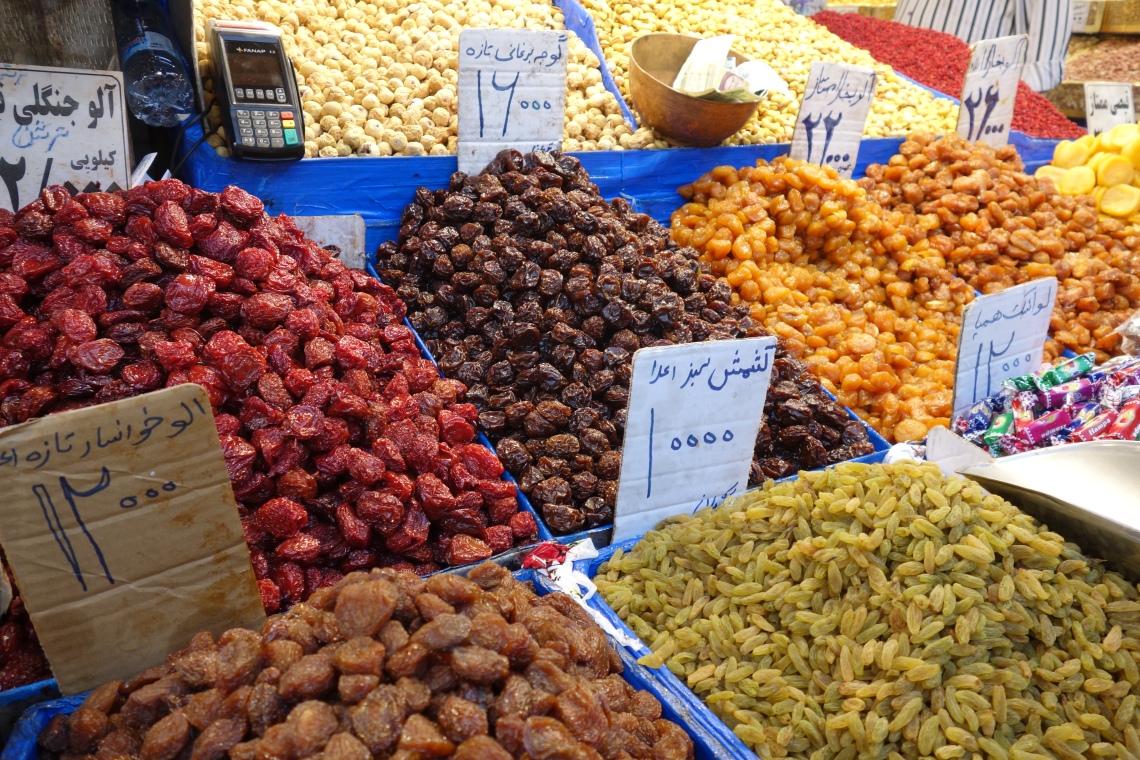
Tucked in a laneway by the Grand Bazaar is a culinary institution of the area. Moslem Restaurant is one of those places where there’s always a long queue and the tables are always packed. Everyone comes for the one signature dish: tachin.
Tachin is what you get when you make a cake out of rice, yoghurt and saffron, and then add chicken and barberries. It’s beautiful, and once you try it you’ll understand why the place is so packed. Considering that many of the restaurants in the country only really serve kebob, this is a great place to try something different. If you’re not in the mood to line up, there’s a takeaway tachin place in the same laneway. It’s nowhere near as good, but still pretty tasty.

Across the road from the Grand Bazaar is the Golestan Palace complex. The seat of the Shah for many centuries, the palace was rebuilt in its current form during the 1800s under the Qajar dynasty. Much of the climate-appropriate architecture continues here from the bazaar. While the exterior is not particularly memorable, the interiors are among the most excessively ornate chambers around.
Mirrors and sparkly chandeliers abound, particularly in the aptly-named Mirror Hall. A kind of 19th-century bedazzlement, these rooms are beautiful despite being so ostentatious. To top it off, the rooms are filled with beautiful gifts from royal families around the world. Unfortunately photography is largely prohibited.
In the wealthy northern suburbs of the city lies the Sa’dabad Complex. Much greener and more expansive than the Golestan complex, this 20th-century compound is slightly less over-the-top and therefore less-impressive than its predecessor. What is does have, however, are several museums housed in the compound’s buildings. They span everything from arts, to royal treasures, firearms, traditional costumes and even tableware.
Being a car-lover, I loved the museum of the royal family’s car collection. Their fleet of Rolls-Royces and Mercedes-Benzes was beautiful. It somewhat made up for the temporary closure of the National Car Museum of Iran during my visit which housed a one-off car I’d wanted to see since I was little.
The other museum that I found particularly interesting was the museum dedicated to the Omidvar brothers. These guys were absolute trailblazers. In 1954 they set out on their motorbikes for a journey around the world. They zig-zagged all around Asia, before circumnavigating Australia, traversing the Americas and returning home via Europe. They didn’t have much money so they made a living giving lectures, creating documentary films and collecting artefacts along the way. Eventually they made a second, three-year-long trip circling Africa. What these guys achieved is literally the stuff of dreams and the museum is a must-see for any avid traveller.
These northern suburbs spill onto the foothills of the Alborz Mountains which loom behind the city. In this district, known as Darband, locals seek respite in the evenings thanks to the much cooler climate here. Revolving around a steep path which follows a stream, this area is packed with kitsch restaurants and qalyan (hookah) bars.

Come at night. It’s glitzy, but in a bit of an Iranian way which might be considered tacky elsewhere. Eat some kebob or ash. It’s not the best food you’ll have in Tehran, but you’re coming for the atmosphere and the food is secondary. This is how the locals cool down, and most tourists will find themselves drawn here for the same reason. Beneath Darband is Tajrish, home to a lively bazaar and decent shopping and restaurants. It’s a lively area, particularly at night, and a good place to wander after some time in Darband.
Tehran’s extensive metro is the perfect way to get around. It’s clean, modern, cheap, and the services are very frequent. Additionally, the metro stations can at times be attractions in themselves. Here you’ll see the best examples of the city’s unique brand of graphic design. Posters against everything from littering to Israel adorn the walls of the stations. The designs mostly adhere to a flat, uncluttered aesthetic, but each one’s individual semiotics are quite clever.
Unfortunately, when I photographed the pro-Palestine posters, a bunch of people in the platform shielded their faces and within a minute I was escorted out of the station by security and asked to delete the photos. A shame really, because I wholeheartedly support the cause.
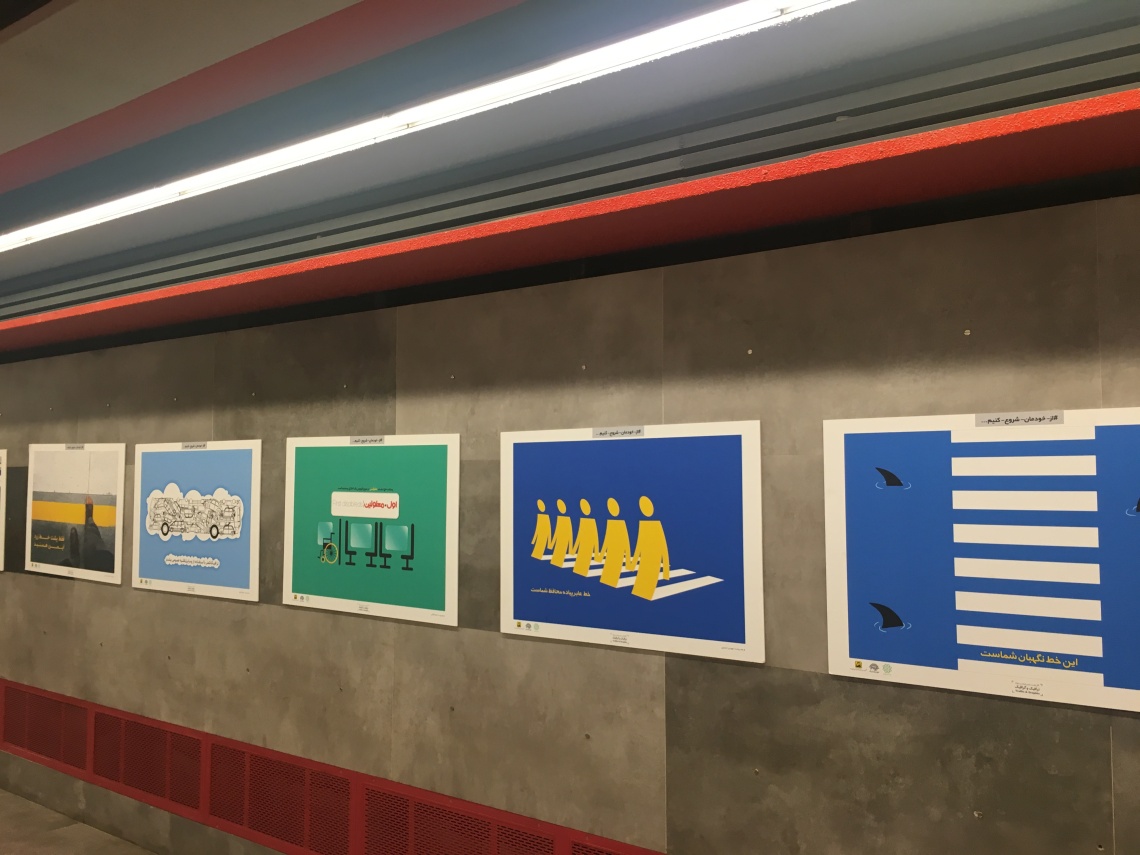
One of the most famous tourist attractions in Tehran is the former US embassy, now known as the Den of Espionage. On my three visits to Tehran I tried to visit but was told politely by the militiamen guarding the building that it was undergoing renovation and closed to tourists. Out the front, however, was a display of anti-American propaganda posters. While belonging to the same school of graphic design as the metro signs, these posters were decidedly more radical. Among them was a portrait of Obama made to look like Osama bin Laden, bombs shaped as Mickey Mouse and the CNN logo as a snake. There were a few stray menorahs thrown in too.
Across the road is the Shohada Museum, or Martyrs’ Museum. This kind of museum has been a feature of every Iranian town since the revolution in 1979. The one in Tehran is the largest, and has heaps of displays dedicated to individual martyrs of the revolution and the Iran-Iraq War. On the top floor is an art gallery full of the same flavour of Iranian political art seen in the subways and on murals.

Just as I was exiting, a man approached me. We started making small talk and he asked about my impressions of the museum. I explained that I had learned a lot about a topic I knew little about, but still had some questions, particularly from the exhibits which were not translated into English. It turns out I was talking with the assistant to the museum’s director. Thanks to that sweet old Iranian hospitality, I was swiftly ushered into the director’s office to chat. Over many cups of tea and a delicious spread of sweets, the director and I talked about Iranian history, modern geopolitics and life in general. Although he spoke no English, and my Farsi vocabulary was limited to a few phrases at best, his assistant was able to act as an interpreter between us.
The director spoke of many moving anecdotes from the Iran-Iraq War. As we began to talk about politics, he opened up the more he realised I also opposed America’s foreign policy. He began to talk candidly about the Christian and Zoroastrian martyrs, and even the Jewish martyrs. At one point he asked me, quite frankly, if I was a Jew. To be fair, I get asked this question semi-regularly back home so I guess I have some kind of Jewish look about me. When I asked why, they said it was because I had a Jewish name. Suuuurrreeee. I told them Jewish names are Christian names and Muslims names too. They conceded immediately.

We talked about all sorts of things. “Do you drink?” he asked. “Not in Iran,” I replied carefully. The two smiled. “What about in Australia?” “Of course,” I told them. They laughed. “Are you a Christian?” “No,” I replied. In most countries, this conversation involves the other person listing every religion they can think of and then being totally surprised at my lack of religion. This time around, the interpreter could already tell. “What is your religion?” I told him I didn’t have one. He didn’t translate what I said this time. Instead, he looked me in the eye and said, “don’t tell him that.”
As the tea began to run out, it was time for the two men to go to pray. Before he bid me farewell, the director handed me a book of Farsi poetry. He had been searching for a book that they had just published in English about non-Muslim martyrs as he noticed they piqued my interest, but it turned out the books hadn’t been delivered yet. The book he gave me instead had poetry in Farsi with Arabic and French translations. His assistant subtly explained that the director had mistaken the French for English. To me, it didn’t matter. I was completely humbled by the gesture, and the book itself was beautiful.
Tehran is a city bisected many times over by highways and interchanges. In the 1960s, Shah commissioned a new masterplan of the city in an attempt to rapidly modernise it. He commissioned none other than Victor Gruen, the Austrian-American architect and planner best known for being the father of the American shopping mall, who worked in collaboration with Iranian Abdol-Aziz Mirza Farmanfarmaian.
The result was that the architectural vernacular of American suburbia was thrust upon the city. In terms of highways, it’s up there with Los Angeles and has the air pollution to match. After the 1979 Islamic Revolution, the masterplan was abandoned on account of its association with the Shah. But the damage had already been done; Tehran is a car-centric city that prioritises traffic jams over walkability.
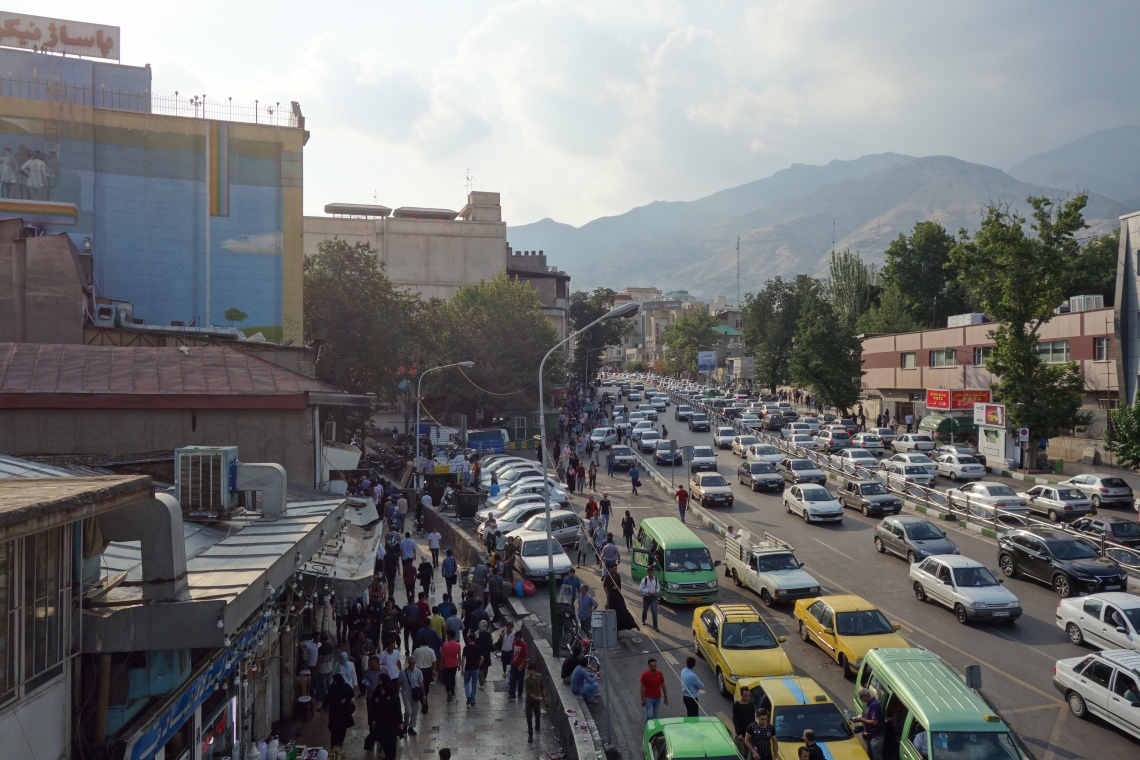
Between these highways is one of the city’s largest and most modern parks, and the pride of many Tehranis. Taleghani Park is a lush oasis between the clogged highways of the metropolis. In many ways it builds upon the practice of locals having picnics on the green nature strips of highway interchanges.
At the park, I met a fellow uni student and his teenage sister. They both spoke great English and knew a surprising amount of Harry Potter references (most of which were lost on me until they were explained). It was fascinating to finally hear about how young people party in this city. The guy occasionally drank and took drugs, usually with his friends in a cabin up the Alborz Mountains somewhere. That’s apparently where many Tehranis go to party away from prying eyes. When I said goodbye and shook hands, I was reminded that there are still some small differences in culture, even between young city-slickers. When the girl went to shake my hand, she more or less grabbed my fist and held it. She was very excited to do so, but clearly it was her first time. It was cute.
This interaction is indicative of the park in general. It’s a space where everyone—young, old, families—but particularly teenagers and young adults come to hang out, away from the restrictions of Iranian law. While the morality police cruise around and hound women for dressing immodesty on the city streets, Taleghani Park seems to be out of their reach. Boys and girls hand out without having to worry about getting in trouble. There are skaters, and plenty of rollerbladers too.
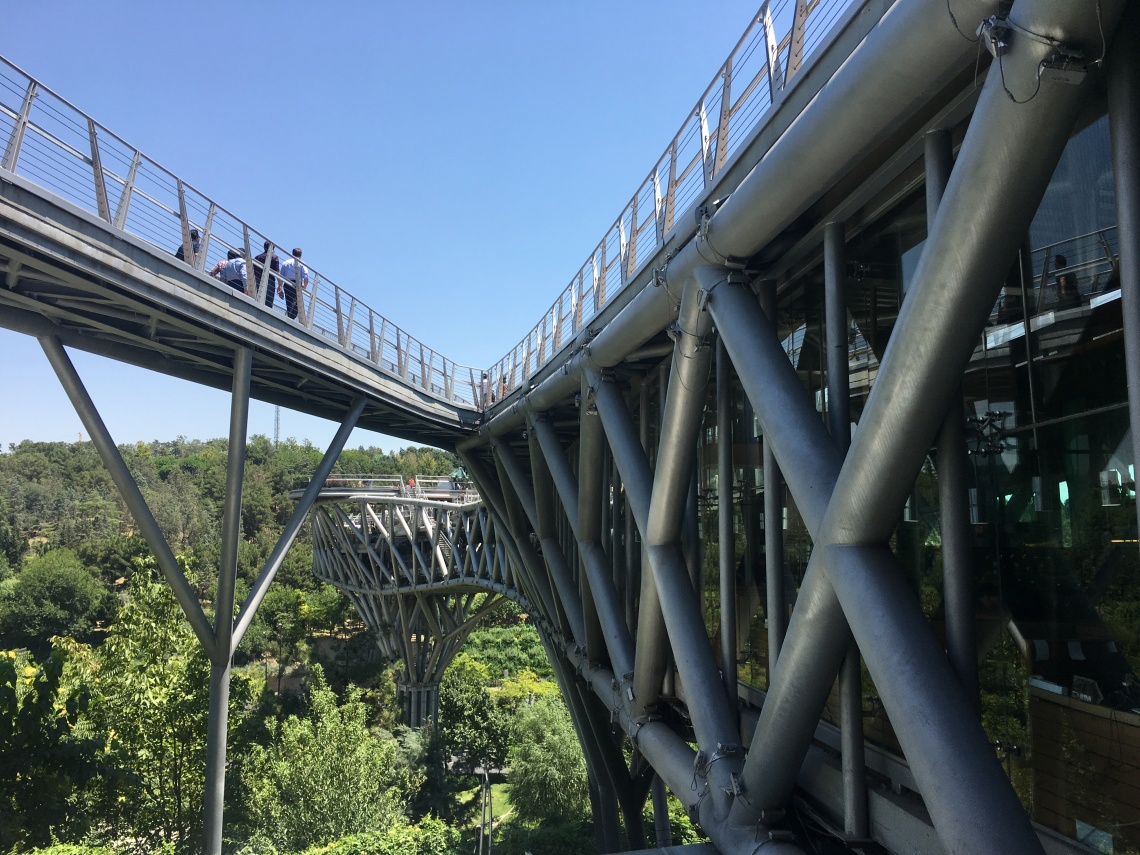
The centrepiece of the park is the Tabiat Bridge, a pedestrian overpass connecting both sides of the park over a highway. It was designed by Leila Araghian, a then-emerging female architect who has since gone on to win numerous international awards for her work. Who better to design a park so loved by young, internationally-minded men and women who are tired of the sanctions imposed on their country?
Just near the park is an array of bombed cars on permanent exhibition. These were the personal vehicles of Iranian nuclear scientists, which the government says have been assassinated by Mossad.

Perhaps the most recognisable sight of Tehran is the Azadi Tower. Build in 1972 as the Shahyad Tower, or Shah’s Memorial Tower, the structure commemorates Iran’s 2,500-year-long history and houses a museum full of artefacts from this period. The gardens surrounding the tower are arranged in a geometric pattern which perfectly compliments the modernist lines of the tower. From the top, you can fully appreciate this as well as look out across the city and towards the Alborz Mountains.
Of course, it wouldn’t be an Iranian tourist sight without Iranian hospitality. As soon as I entered the museum in the basement of the tower, I was approached by a lawyer and his visiting nephew who both spoke a little bit of English. Aside from the usual friendly small-talk, the two began showing me around the museum and the tower itself, acting as guides. They didn’t expect anything and had no agenda, they were simply being welcoming and were proud to share their country’s history.
Tehran’s other tower is the Milad Tower, the 6th-tallest in the world. I was never able to go up, but when I did visit I was able to hang out with some teenage refugees from Afghanistan. They were the sweetest guys ever.
Iran has always evoked exotic connotations in the eyes of foreigners in the past. Be it images of the country’s deserts, preconceptions about the culture, or opinions formed in the current political climate, the country has always been treated as the other in the eyes of Westerners. But while the culture in Tehran is unique, and the climate is special, and yes, even the politics are radical, Tehran is a normal city. It’s a great city—lively, cosmopolitan, welcoming—but at the end of the day it’s normal. Forget about exotic experiences and culture shock, because this city is fun simply because there is so much great stuff on offer. And that’s all the more reason to visit.

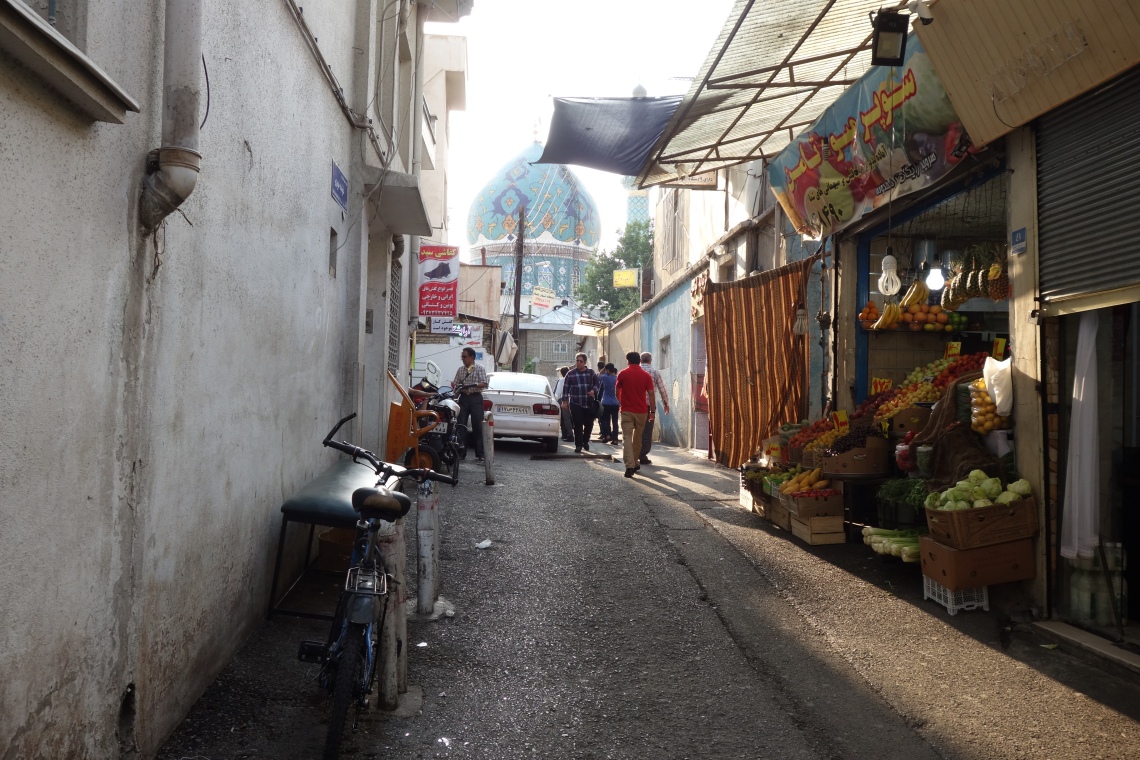
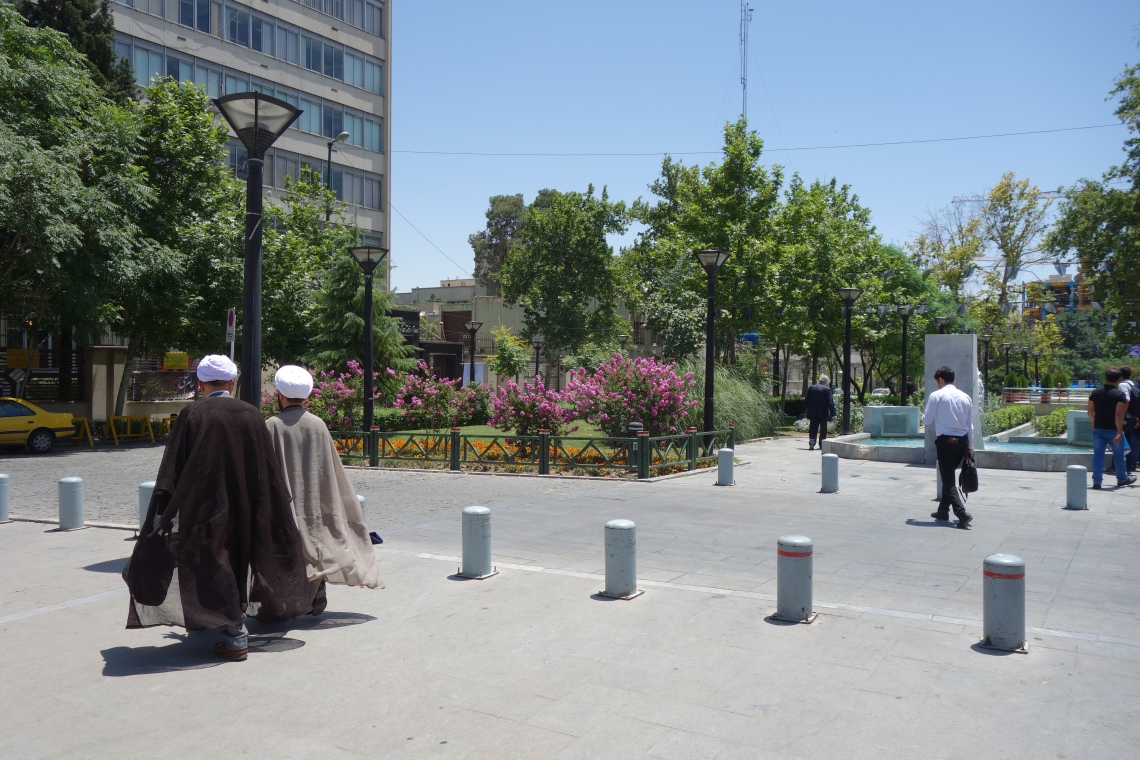
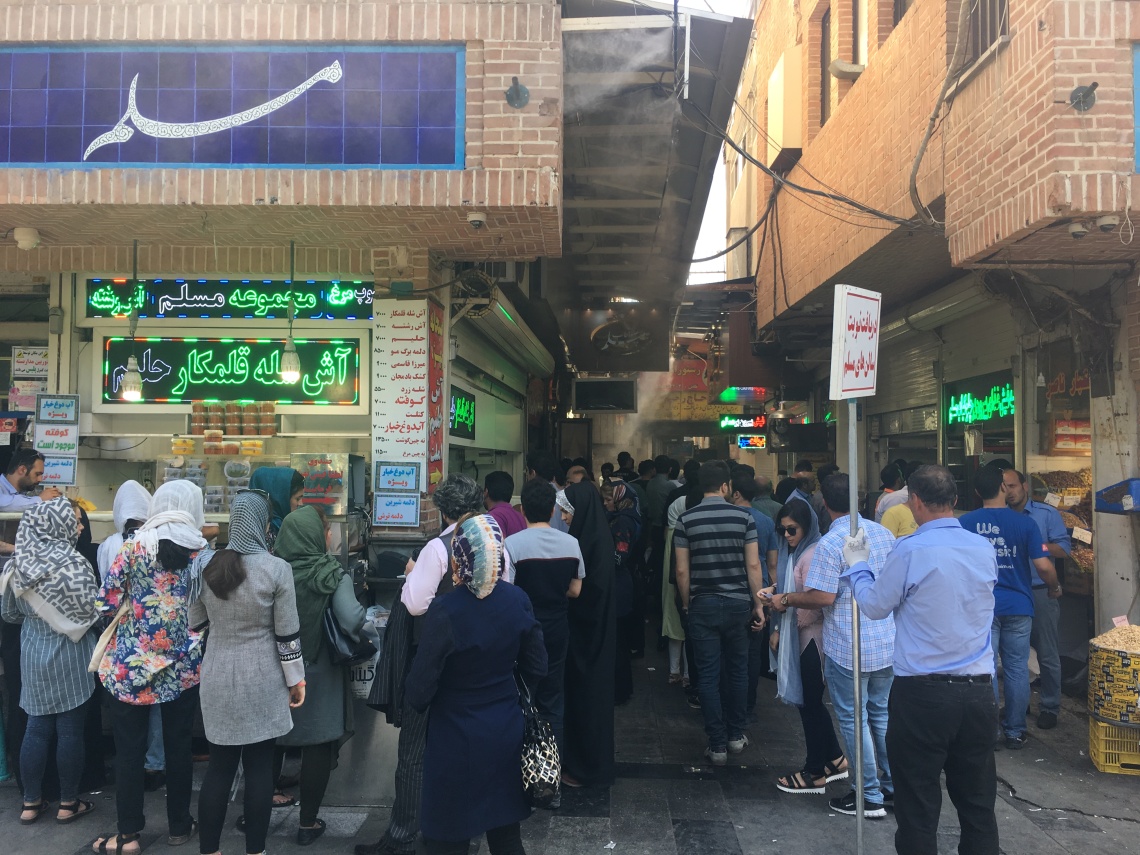







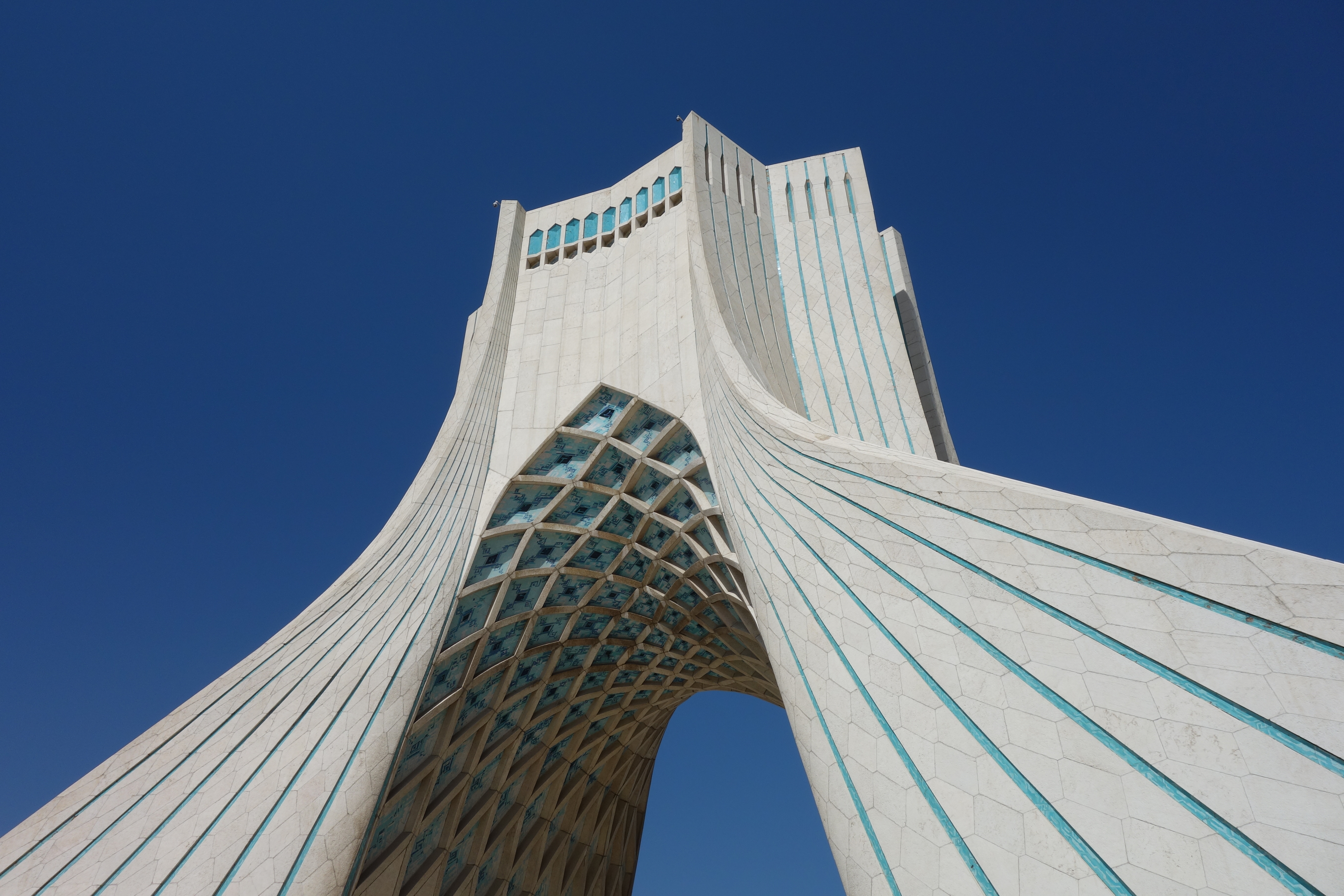

















Love reading about your adventures and your type of travel. Thanks for writing your blog. I usually avoid cities, but this sounds worth the visit.
LikeLike
Glad you enjoyed the read, thank you!!
LikeLike
Great article and I really like the photos as well!
LikeLike
Thank you! The city’s not photogenic in the traditional sense but it’s still vibrant and visually appealing!
LikeLike
Iran. A country I’ve been dreaming to go mainly because of the ruins of the Achaemenid Empire and the beautiful Persian Islamic architecture. There was one time when I actually contacted Nate because I was interested in joining his tour. But I realized my annual leave wasn’t enough for me to do that trip, so I opted to go to other places instead. Your post reminds me to really make a plan to go to Iran.
LikeLike
I was actually the opposite, more interested in more modern attractions such as those in Isfahan, and the culture in general. But when I did see ruins, I was blown away every time. I came away with a newfound appreciation for the history and have learned so much! But yeah, Iran is a big country with lots to see, so you probably made the right choice if you didn’t have a long window to visit.
LikeLiked by 1 person